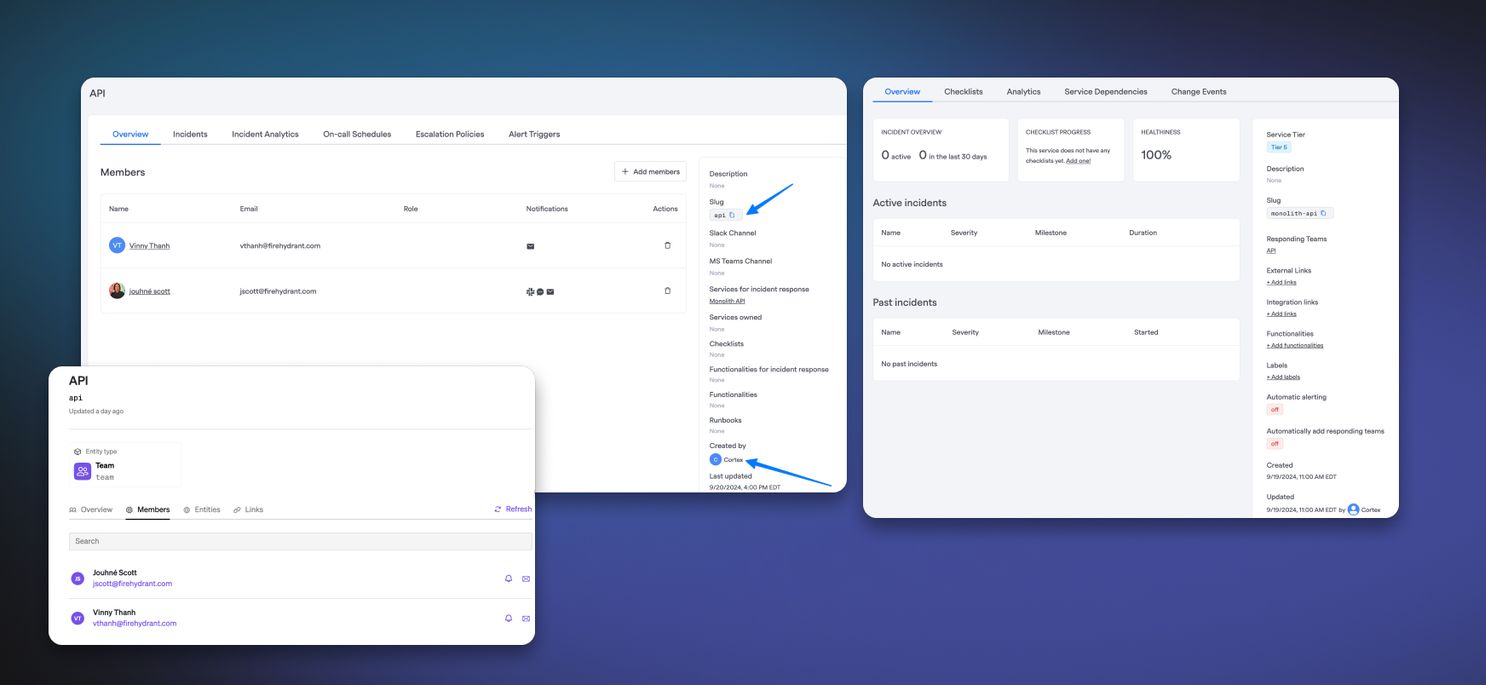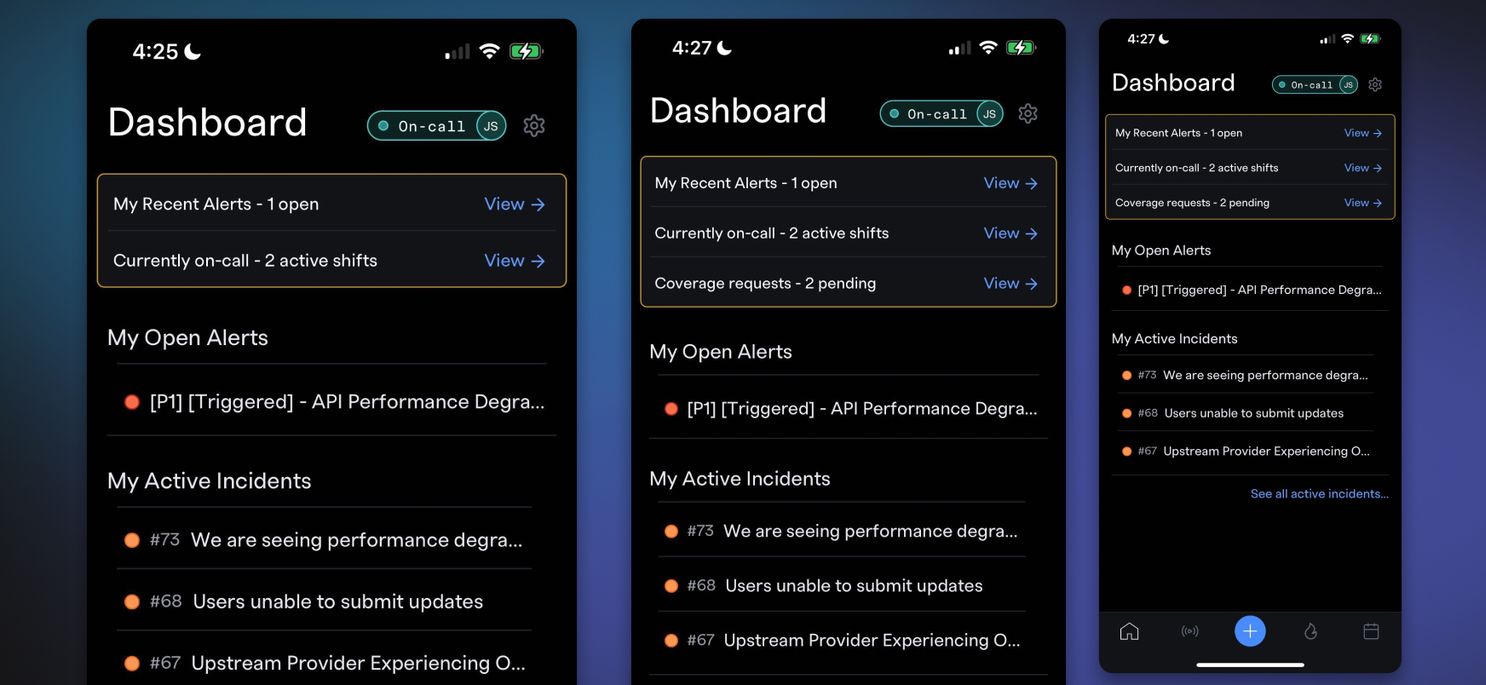
Cortex Integration#cortex-integration

We're pleased to announce the integration of Cortex with FireHydrant. This new feature allows you to import Catalog entities from Cortex directly into FireHydrant, streamlining the management of your microservice ecosystem. Additionally, you can now synchronize team and service information between the two platforms, ensuring consistent and up-to-date data across your tools.
This integration enhances your ability to leverage Cortex's comprehensive service catalog within the FireHydrant environment, improving visibility and coordination in your microservice management and incident response workflows.
What this means for you#what-this-means-for-you
Simpler service management - by importing Cortex Catalog entities into FireHydrant, you can manage your microservices from a single platform, reducing complexity and saving time.
Faster incident response - with up-to-date service information readily available in FireHydrant, your team can quickly identify affected services during incidents, leading to faster resolution times.
Better team collaboration - synchronized team and service data ensures that all stakeholders have access to the same information, facilitating better communication and coordination across departments.
Less manual work - automatic synchronization between Cortex and FireHydrant eliminates the need for manual data updates, minimizing errors and ensuring data accuracy.
Big picture view - by combining Cortex's service catalog with FireHydrant's incident management capabilities, you gain a comprehensive understanding of your microservice ecosystem and its performance.
Teams can significantly improve their operational efficiency, reduce mean time to resolution (MTTR) for incidents, and maintain a more robust and reliable microservice infrastructure through this powerful integration.
To learn more about the Cortex integration, check out the documentation.
Mobile Dashboard#mobile-dashboard

We've given our iOS and Android apps a fresh new look with a home screen that puts everything you need front and center. You'll see your on-call status at a glance, plus quick access to recent alerts, active shifts, and coverage requests. We've also streamlined navigation, making it easier to find what you're looking for.
What this means for you#what-this-means-for-you
Manage alerts, check shifts, and handle coverage requests with fewer taps, making your work smoother and more efficient.
With this update, we're making your on-call life a little bit easier. Enjoy the new dashboard!
Head over to the App Store or Google Play Store now and download the latest version of our app.
Other Improvements and Bug Fixes#other-improvements-and-bug-fixes
💅 You'll now see custom measurement definitions displayed in the services, functionalities, environments, and teams pages. Instead of hardcoded headers and data, the tables now dynamically pull information from the API response, giving you a more accurate and tailored view of your metrics.
💅 When publishing a retrospective, you can choose a specific milestone to associate it with. Additionally, you'll see a handy "Download PDF" button when viewing a retro. This allows you to easily share the retrospective with your team or stakeholders.
💅 We've polished up our incident status templates in Slack for a smoother user experience. Now, instead of seeing raw Liquid code, you'll see the fully rendered template in your incident updates. This change ensures that your status updates are immediately clear and readable, without any distracting code snippets.
💅 We've streamlined our example placeholder for custom event sources. While we previously showcased a comprehensive function to demonstrate the full power of JavaScript, we realized a simpler approach could be just as effective. The new, more concise example includes helpful comments, providing a clearer starting point without overwhelming our users.
💅 We've enhanced our API to help you stay in the loop about your team's notification preferences. Now you can programmatically check if your teammates have enabled Signals notifications, including push and email alerts. This API update gives you better visibility into how your team is staying informed, helping you ensure everyone's on the same page when it comes to important alerts.
💅 We've standardized the naming of follow-ups across our platform. This update ensures consistency and clarity in how we reference them moving forward.
💅 We've improved the readability of runbook rows by wrapping text in the category cell. This small but impactful change helps you see full category names at a glance, making your runbooks easier to navigate and understand.
🐛 We've updated our change events API to play nicely with our catalog entries. Now, you can use friendly ID slugs for services and environments when creating change events. This fix to the POST /v1/changes/events endpoint makes it easier to associate services and environments with your change events.
🐛 We've squashed a bug that was getting in the way of filtering resolved alerts by team. We now check for both the alert's Team and the associated Alert Trigger for team information. This means you can now easily find all resolved alerts for a specific team, giving you a clearer picture of your alert history.
🐛 We've fixed a bug that was blocking you from reusing names of deleted Severities and Priorities. You're now free to create new ones with those familiar names, giving you more flexibility in organizing your work.
🐛 We've patched an issue with our Slack framework that was giving some customers trouble with the /fh new command. We've gone through the framework and added additional label truncation to resolve this issue.
🐛 We've updated how we display the configured or unconfigred tag on the project table for users who have custom milestones. This change comes after implementing custom milestones. Now, to be marked as "configured," both the incident default issue type and the first milestone need to be set.
🐛 We've squashed a couple of bugs on the teams page related to our custom milestones feature. You'll now see correct tooltip names instead of the old ones that were hanging around. We've also fixed how column data is passed to the charts, so they should be displaying accurately now.
🐛 We've fixed a tricky bug related to incident milestones. Previously, incidents could end up with an invalid "started" milestone if you had customized your milestone setup. Now, when an incident is created, we ensure it's assigned to the first valid milestone in your organization's configuration.
🐛 We fixed a bug that was giving some users trouble with hiding the "Priority" field. You should now be able to customize your incident form fields as intended, including hiding the Priority field if desired.
🐛 We've fixed a bug that prevented users from reopening incidents with required impact fields. The issue stemmed from a recent change related to custom milestones, which inadvertently caused all impacts to be removed when re-opening an incident. Now, you can smoothly reopen incidents even when services, functionalities, or environments are set as required fields.
🐛 Some users were running into issues when trying to resend an invitation that had failed initially. We've updated our system to skip the unique email check when resending invites, so you should now be able to get those invitations out without a hitch.
🐛 We've rolled out a bundle of improvements to enhance your alert analytics experience. We've fixed filtering issues on alert attributes, refreshed the heatmap colors for better visibility, and made several UI enhancements to the alert analytics page, including more accurate links and improved chart displays.
🐛 We've streamlined the incident closure process for a smoother user experience. Now, when you submit a close request, the modal will automatically close, giving you instant feedback on your action.
🐛 We've improved navigation for project pages. Now, if you try to access a non-existent project, you'll be automatically redirected to the main projects page, ensuring you always land in a useful spot.
🐛 We've updated the alert modal to be more intelligent in displaying linked incidents. If an alert has no linked incidents, we will now assume that there are no linked incidents to show in the alert modal's link view.